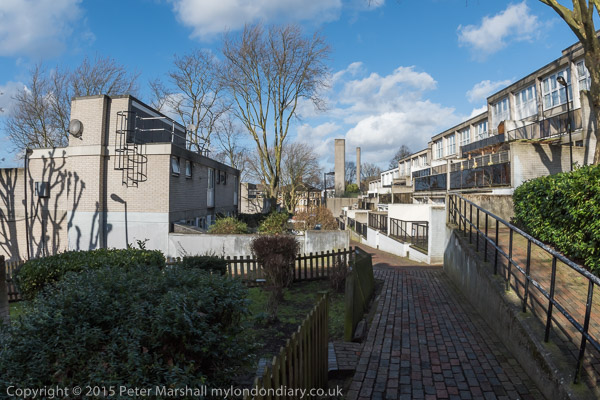
One of the best post-war estates in London, but surprisingly unlisted, Central Hill is on a slope from the road of that name going down towards the north with extensive views of Central London. Architect Rosemary Stjernstedt (1912–1998) working for Lambeth Council made great use of the site, with large areas of open space, play areas, community buildings and a district heating system. and it was well-built by John Laing, the 374 homes being completed in 1974. Like most council estates it suffered over the years from neglect, though it has been freshed up considerably since I first photographed there in the 1996.
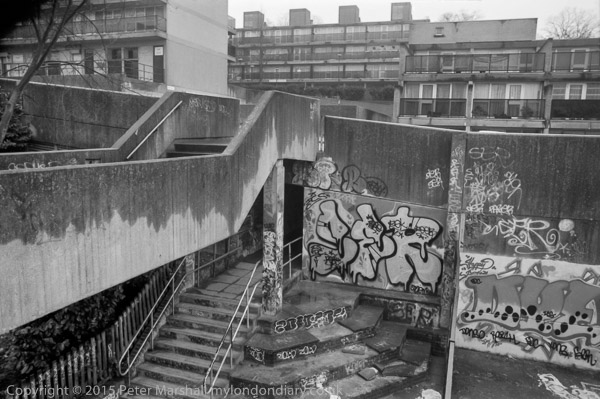
1996: The graffiti and this car park area and subway were removed when the estate was renovated
It is now threatened with demolition – though still a very popular estate with residents. You might ask why Lambeth council want to knock all or most of it down, and the reason is really that it is a well-planned estate – and thus at what is now considered a low density. I think there is also a feeling – not just in Lambeth – that council tenants shouldn’t be allowed to live in nice houses.
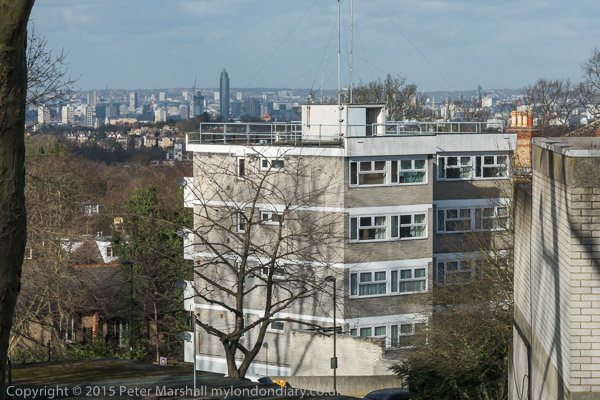
This site is certainly one that makes developers and estate agents salivate; those views across London will gaurantee high prices for private properties here, along with decent local shops and transport links. Its a short walk (or ride) to Gipsy Hill and Crystal Palace stations, and to one of London’s nicest parks, Crystal Palace Park.
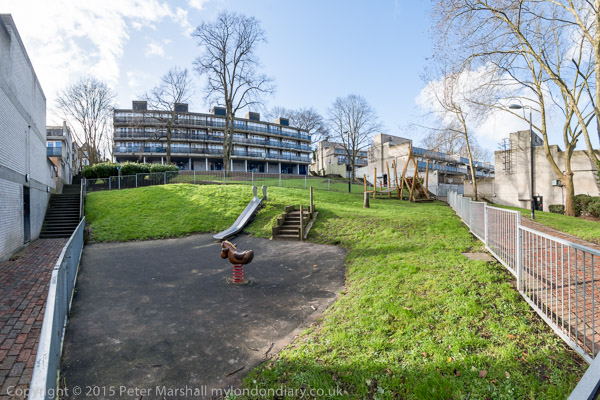
I’d heard about the plans to demolish the estate from friends, and at the end of January The Guardian published a piece about it by Rowan Moore, and I thought about going to look at it again for myself. And on Feb 2nd the weather forecast was good and I had nothing else pressing, so I took the train to Gipsy Hill and walked up. All of the colour pictures here come from that visit, and there are many more at Central Hill Estate on My London Diary.
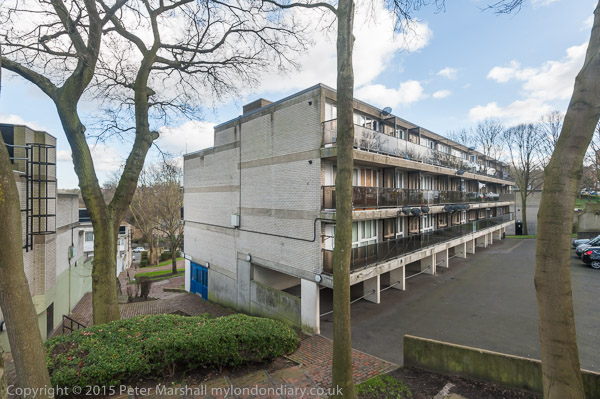
Many of the pictures I took were with the 16mm Nikon fisheye – and then converted to a cylindrical view with the Fisheye-Hemi plugin to make the verticals more or less vertical. This gives a horizontal angle of view of around 147 degrees. Except in the centre of the view, non-vertical lines remain curved, and this may sometimes look disturbing. It’s usually best to avoid photographing buildings ‘square on’.
But on this occasion I took rather a lot before realising that I was using the lens only on the 16Mp DX format, which isn’t really a great idea. I usually use D810 as a DX camera with the 18-200mm, which gives me the equivalent of a 27-300mm zoom but at around a quarter of the wieght. For this I have to set the camera into DX mode manually, and I’d left the camera on that setting when I changed to the fisheye. The difference in the viewfinder is of course obvious, but I’m so used to seeing a masked area around the image it just didn’t occur to me anything was wrong.
I walked around the estate taking pictures at the DX setting with the 16mm fisheye before I realised and set it back to FX. You can still use the plugin to straighten the verticals, by putting an appropriately sized ‘canvas’ around the image, using the plugin and then cropping the blank area off, but it’s something of a pain, and not normally worth doing, as you can get a wider view more easily with the 16-35mm. The curvature isn’t always very noticeable – and is visible in the uncorrected image at the top of the post.
Once I realised I switched to the 32Mp FX mode, and went to retake some of the earlier pictures with a much wider view. Fortunately I had taken quite a few pictures with the 16-35mm, usually at the 16mm end. But I did have to rush around a little to be sure to catch my train home while my ‘Super Off-Peak’ ticket was still valid.
When photographing events I usually don’t bother to correct the geometric distortion on these images in Lightroom – my default has distortion correct at zero. At 16mm, where most of these pictures at Central Hill were taken, there is considerable pincushion distortion visible unless I’ve remembered to change the distortion correction to 100%.
More of my pictures from 2016 at Central Hill Estate. You can read about to save the estate from demoition at Save The Central Hill Estate, and sign their petition. There are also alternative plands for increasing the density of the estate while retaining the original from Architects of Social Housing.
______________________________________________________
There are no adverts on this site and it receives no sponsorship, and I like to keep it that way. But it does take a considerable amount of my time and thought, and if you enjoy reading it, the occasional small donation – perhaps the cost of a beer – would be appreciated.
My London Diary : Buildings of London : River Lea/Lee Valley : London’s Industrial Heritage
All photographs on this and my other sites, unless otherwise stated, are taken by and copyright of Peter Marshall, and are available for reproduction or can be bought as prints.
To order prints or reproduce images
________________________________________________________